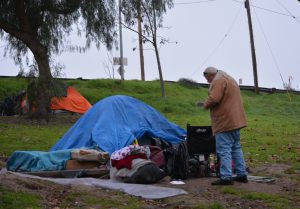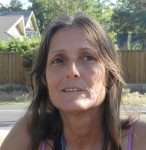
When Randy Limburg saw the crutches and wheelchair in front of the tent, his first thought was Cheri. The woman with one leg had been in the park for several years, and always refused to leave.
“That you Cheri,” said Limburg. “You in there?”
Probably because Cheri knew him, Limburg got a response, but he couldn’t get Cheri to come out of the tent. She answered a few questions from inside so that Limburg and his team could fill in their homeless survey questionnaire and move on.
Last Wednesday, Limburg and his partners Nora Martinez and Maria Madrigal were part of the annual count of homeless people in Stanislaus County. Limburg himself was once a heavy drug user and homeless for several years. He’s got a first-name relationship with dozens of the people he encounters in his work for the Telecare Mental Health Facility, many of whom he’s known for well over a decade.
“Cheri’s had plenty of chances to get help,” said Limburg. “She just won’t go in.”
Even when the police periodically order people out of Beard Brook Park for violating camping ordinances, Cheri simply moves to the parking lot or across the street until the police are gone, then returns to the park. She’s only one of many homeless people who seem committed to life outside, no matter how difficult.
On the surface, it appears that homeless people like Cheri choose to be homeless. Beneath that surface is a much more complex story.
According to the conventional wisdom, all a homeless person has to do to get help is access one of dozens of services available for people in need. And in fact, Stanislaus County has some excellent services, including the Telecare Facility and the Stanislaus Recovery Center (SRC), among many others.

These facilities are almost always staffed with excellent personnel. Treatment generally follows professionally approved guidelines. People in treatment can get anywhere from three days to three months superb care, and often receive help with transitional shelter. Problems begin when shelter options end, or aren’t available at all.
“I had help from family,” says Limburg today, and family can be the single most important factor in recovery from homelessness. But many people on the streets don’t have such help, either because their families have given up on them, can’t supervise them as needed, can’t afford another mouth to feed, live elsewhere, or are deceased. Without family to provide shelter, even people who have received the best of care end up back on the streets.
That was the case with Mary, who after fifteen days at Modesto’s Behavioral Health and Recovery Services was back on her prescribed meds and seemed to have made a miraculous escape from the demons of paranoid schizophrenia. When released, she had nowhere to go but back to the park where she’d been found wandering through her world of vivid delusions. Within a couple of weeks, she was off her medicine and again fearful of the eight underground men who haunted her tortured imagination.
Then there’s Steve, whose record includes ten “rehabs.” Once his shelter options run out, he’s back outside with nowhere to go.

Last we checked, Rosario had just been released from yet another stint in jail for trespassing. She’s almost certainly back on the streets, where she’s been since 2011, not counting frequent short-term jail stays. Local outreach people believe she suffers from anosognosia, a condition that describes mentally ill people who believe they are perfectly sane.
Some cities and states have figured out that it costs far less to provide homeless people with subsidized housing than it does to subject them to endless rounds of rehabilitation and jail time that always end in another cycle of homelessness. But the “Housing First” movement still hasn’t caught on in many places, mostly because too many people believe homeless people “choose” to be homeless and deserve to be on the streets.
That’s the major reason why Randy Limburg’s friend Cheri and hosts of other homeless people will likely be answering his questions next year, when yet another winter survey finds them huddled in a tent or shivering on the street.

Good article. A perplexing problem, best solved by a combination of government and private resources.